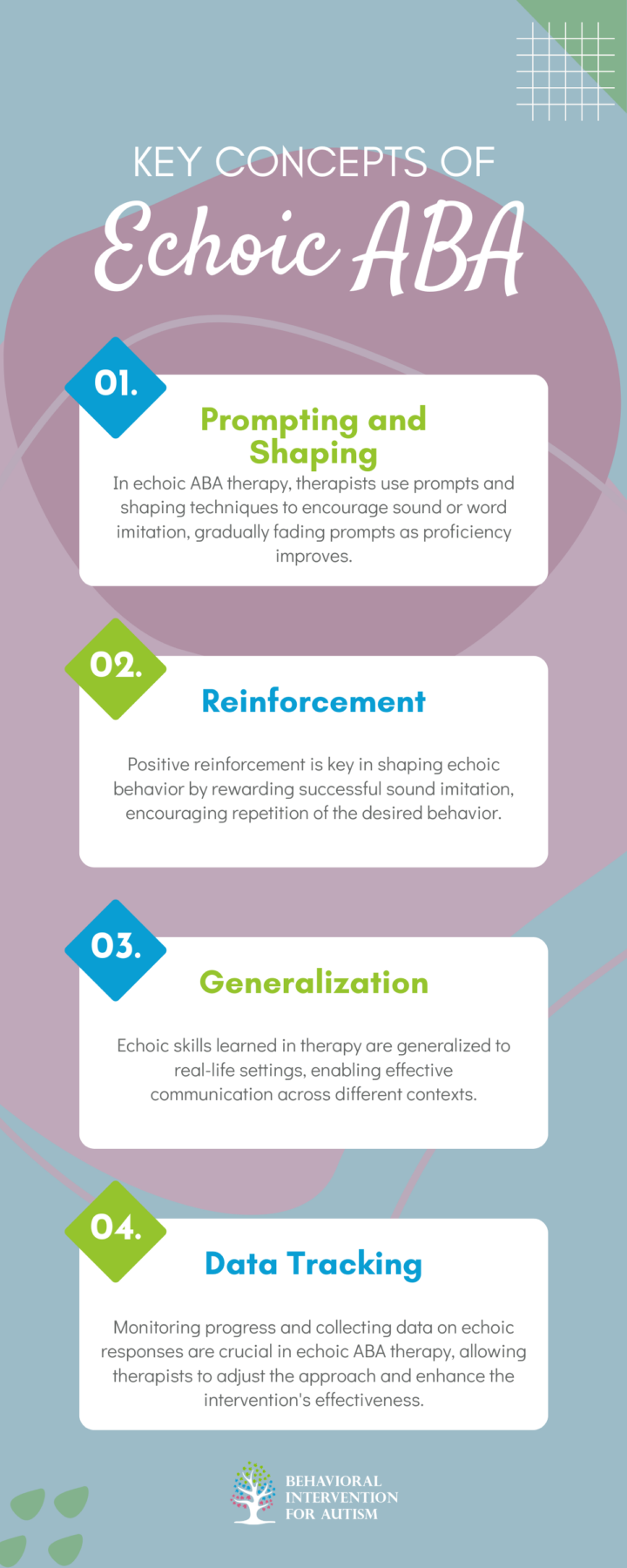
Table of Contents
In the realm of ABA therapy, understanding the concept of echoic behavior plays a significant role in enhancing communication skills and language development in individuals with autism. We will explore the essence of echoic in ABA therapy and examine the key concepts that support this therapeutic approach.
What is Echoic in ABA Therapy?
Echoic behavior in ABA therapy refers to the repetition of verbalizations or sounds that are heard. It involves the individual imitating or echoing the words or sounds produced by another person. This form of imitation is crucial for language development and communication as it helps individuals with autism learn to vocalize and articulate words effectively.
Echoic behavior is often used to teach individuals with autism to echo specific sounds, words, or phrases. By reinforcing these echoic responses, therapists can help individuals improve their verbal skills and expand their language repertoire. The goal of echoic in ABA therapy is to promote verbal communication and strengthen language abilities.

Implementing Echoic ABA Techniques
In the realm of ABA therapy, implementing effective techniques for teaching echoic skills is pivotal in enhancing communication for individuals with autism. By focusing on strategies tailored to develop these skills and emphasizing the significance of consistency and repetition, caregivers can foster meaningful progress and growth in individuals with autism.
Strategies for Teaching Echoic Skills
Teaching echoic skills involves employing various strategies that are designed to enhance verbal imitation and auditory processing in individuals with autism. Some effective strategies include:
- Modeling: Caregivers or therapists model the desired verbal response for the individual to imitate.
- Prompting: Providing prompts or cues to help the individual produce the correct verbal response.
- Verbal Reinforcement: Offering praise or rewards for accurately echoing a sound, word, or phrase.
- Incremental Learning: Breaking down complex verbal responses into smaller, manageable components for easier learning.
- Visual Aids: Using visual supports such as pictures, cards, or cues to facilitate understanding and imitation.
These strategies aim to create a supportive and structured learning environment that encourages positive communication outcomes for individuals undergoing echoic ABA therapy.

Importance of Consistency and Repetition in Echoic ABA
Consistency and repetition play a crucial role in the success of echoic ABA therapy. By ensuring a consistent approach to teaching echoic skills and incorporating frequent repetition into the learning process, individuals with autism can strengthen their vocal imitation abilities and enhance their overall communication skills.
Benefits of Consistency and Repetition in Echoic ABA Therapy: |
Reinforcement of Learning: Consistent practice and repetition reinforce the acquisition and retention of echoic skills. |
Establishing Patterns: Repetition helps individuals recognize speech patterns and improve their ability to echo sounds and words accurately. |
Building Confidence: Consistent reinforcement and practice build confidence in individuals as they successfully master and replicate verbal cues. |
Generalization of Skills: By consistently practicing echoic skills in various settings, individuals can generalize their communication abilities beyond therapy sessions. |
Emphasizing consistency in teaching echoic skills and integrating repetitive learning opportunities allows caregivers and therapists to create a supportive environment that nurtures effective communication strategies in individuals with autism.
Benefits of Echoic ABA Therapy
Echoic ABA therapy, a fundamental component of ABA therapy, offers a range of benefits for individuals with autism spectrum disorder (ASD). By focusing on the development of echoic skills, this therapy approach aims to enhance communication, improve language abilities, and foster positive social interactions.
Enhancing Communication Skills
One of the primary advantages of echoic ABA therapy is its effectiveness in enhancing communication skills among individuals with ASD. This therapy helps individuals learn to imitate and replicate sounds, words, and phrases, which is crucial for developing functional communication abilities. By practicing echoic skills, individuals can improve their ability to express their wants, needs, and thoughts effectively.
Improving Language Development
Echoic ABA therapy plays a significant role in the overall language development of individuals with autism. By teaching individuals to repeat and vocalize sounds and words accurately, this therapy approach helps strengthen language skills. Through consistent practice and reinforcement, individuals can expand their vocabulary, improve pronunciation, and gain confidence in their verbal communication abilities.
Enhancing Social Interactions
Effective communication and language skills are essential for fostering positive social interactions. Echoic ABA therapy equips individuals with the necessary tools to engage in meaningful interactions with others. By improving communication and language proficiency, individuals with ASD can increase their social engagement, develop relationships, and participate more actively in various social settings.
Challenges and Considerations
Engaging in Echoic ABA Therapy involves challenges that necessitate strategic approaches. Key aspects to address include overcoming barriers in therapy and implementing individualized techniques tailored to each person’s unique needs.

Overcoming Barriers in Echoic ABA Therapy
While Echoic ABA Therapy can be highly beneficial for individuals with autism, certain barriers may impede progress. One common challenge is the variability in individual responses to the therapy. Not all individuals may respond in the same way or at the same pace to echoic prompts. It’s crucial for therapists and caregivers to adapt their approach and techniques based on the individual’s specific needs and learning style.
Another barrier is the need for consistent reinforcement and practice. Maintaining consistency in implementing Echoic ABA techniques is essential for reinforcing learned behaviors and promoting skill retention. Lack of regular practice and reinforcement can hinder the effectiveness of the therapy and slow down progress. Caregivers and therapists play a vital role in ensuring a structured and consistent approach to Echoic ABA Therapy.
Individualized Approach in Implementing Echoic Techniques
One of the fundamental principles of ABA Therapy is the individualized approach to treatment. This holds true for Echoic ABA as well. Each individual with autism has unique strengths, challenges, and communication preferences. Therefore, it is crucial to tailor Echoic techniques to suit the specific needs and abilities of the individual.
Assessing an individual’s communication skills, preferred learning style, and behavioral patterns allows therapists and caregivers to create a customized plan for implementing Echoic ABA Therapy. This personalized approach ensures that the therapy is effective, engaging, and motivating for the individual.
The individualized approach also involves ongoing assessment and adjustment of the therapy plan to accommodate the individual’s progress and evolving needs. Regular communication and collaboration among therapists, caregivers, and other professionals involved in the individual’s care are essential for optimizing the outcomes of Echoic ABA Therapy.
Echoic behavior refers to the ability to accurately repeat sounds or words that one hears, and it plays a vital role in language development. Understanding this concept is essential for implementing effective ABA strategies, particularly in fostering communication skills.
Our dedicated team at Behavioral Intervention for Autism utilizes evidence-based techniques within our ABA programs in Florida, ensuring that each child receives personalized attention tailored to their unique needs. We strive to create a supportive environment that promotes learning and growth. If you want to enhance your child’s communication abilities, connect with us today to learn how we can help!
- 9 Common Obsessions of Children With Autism You Should Know - February 25, 2025
- What is Neurodiversity? A Guide to Embracing Differences - February 25, 2025
- Understanding Hyperfocus in Autism: What It Means and Why It Happens - February 25, 2025
